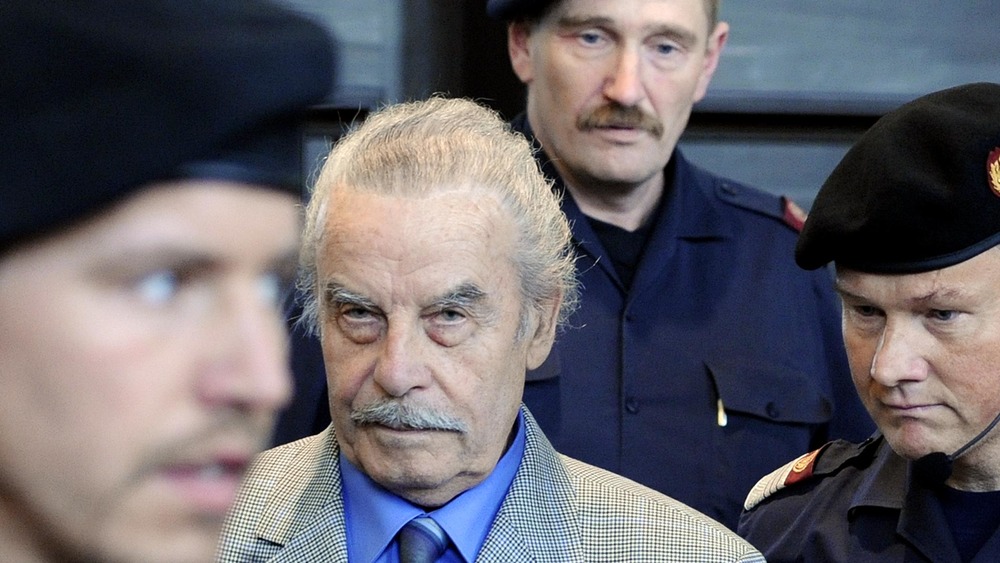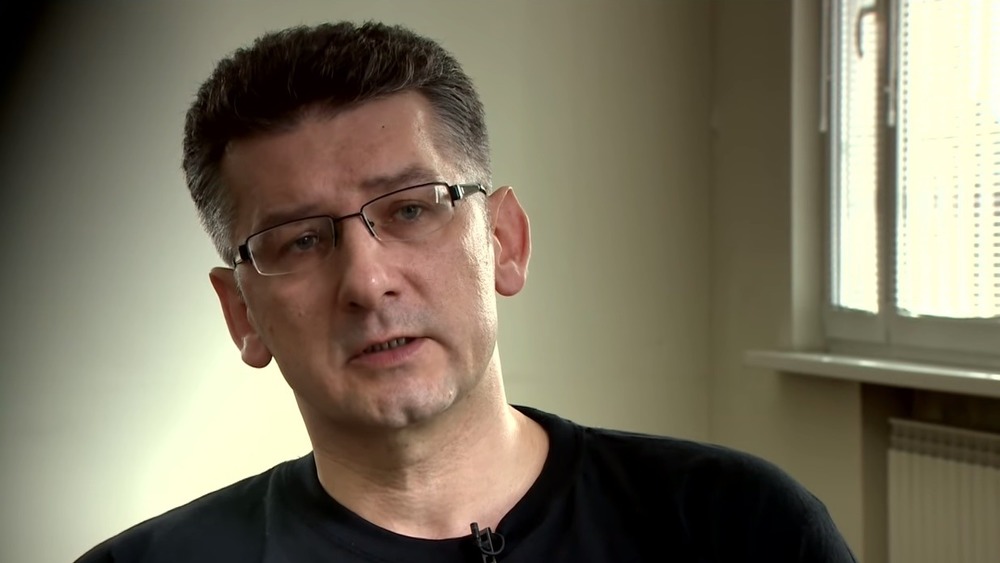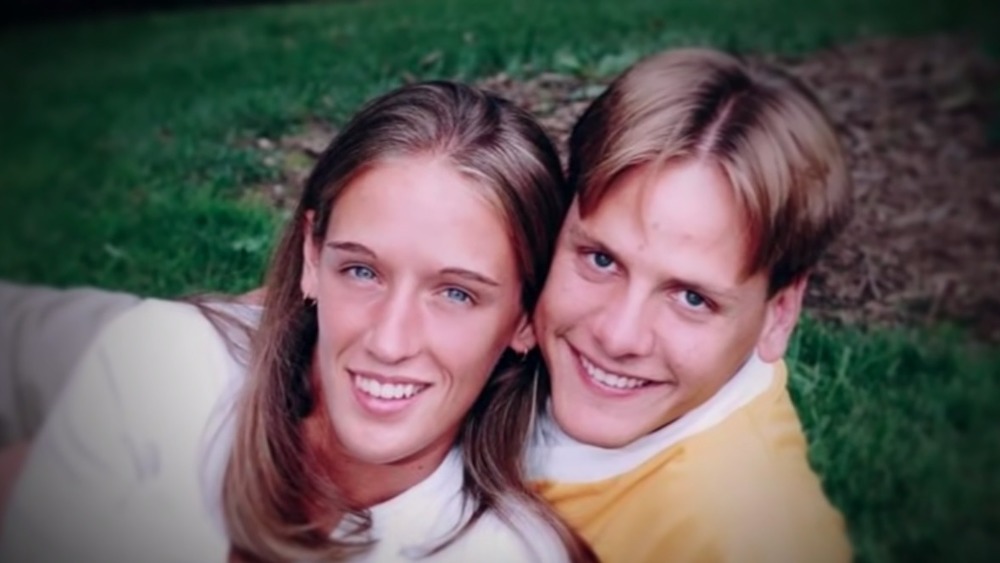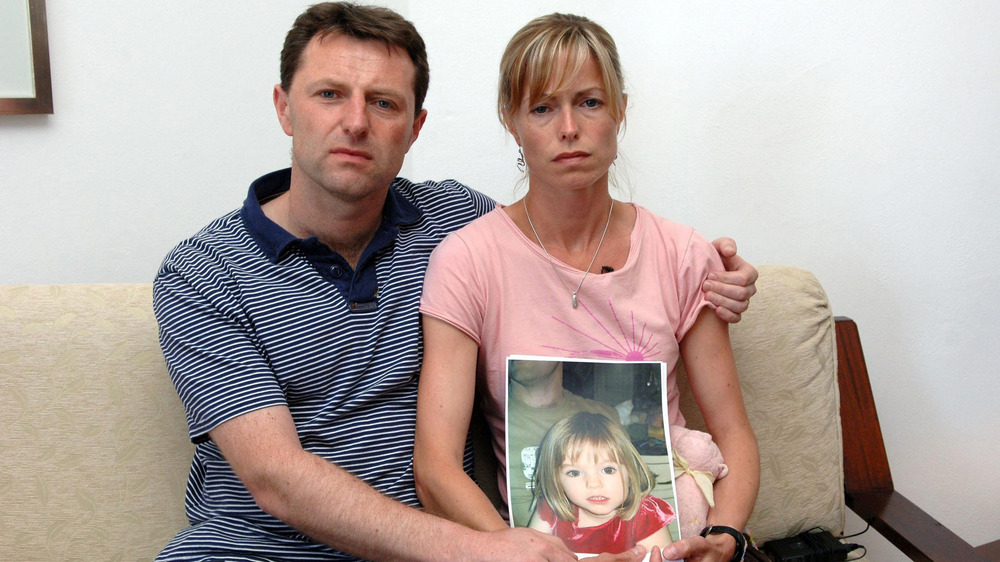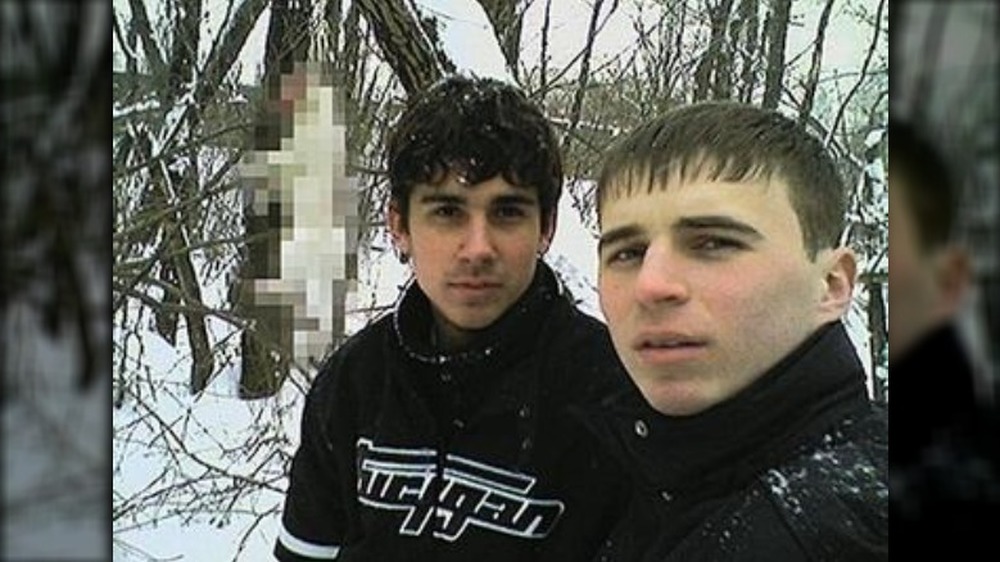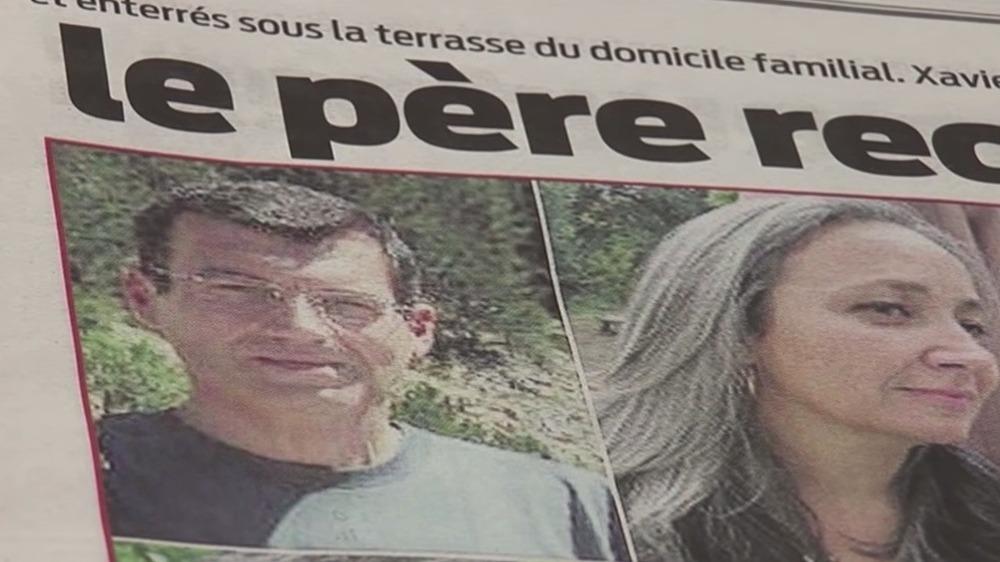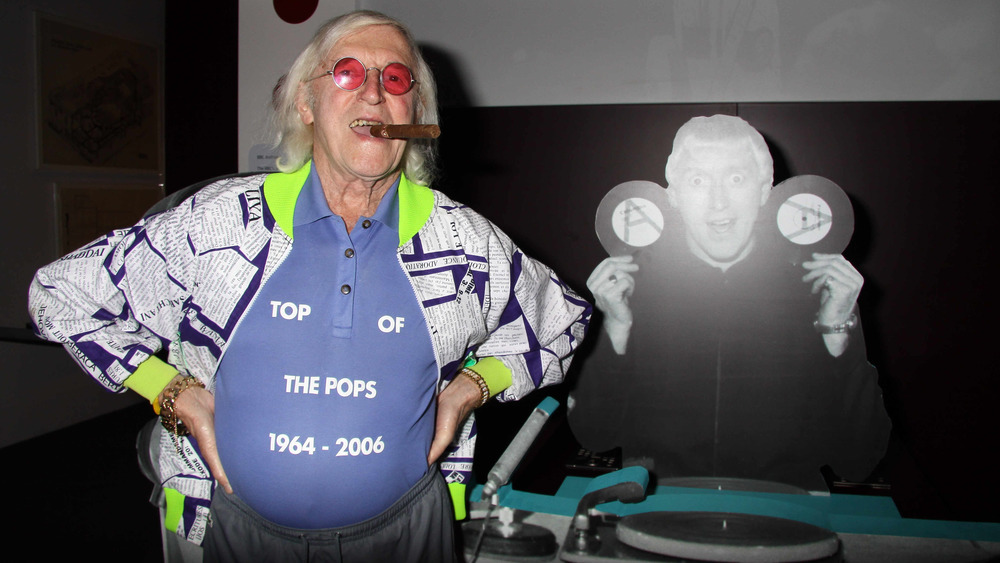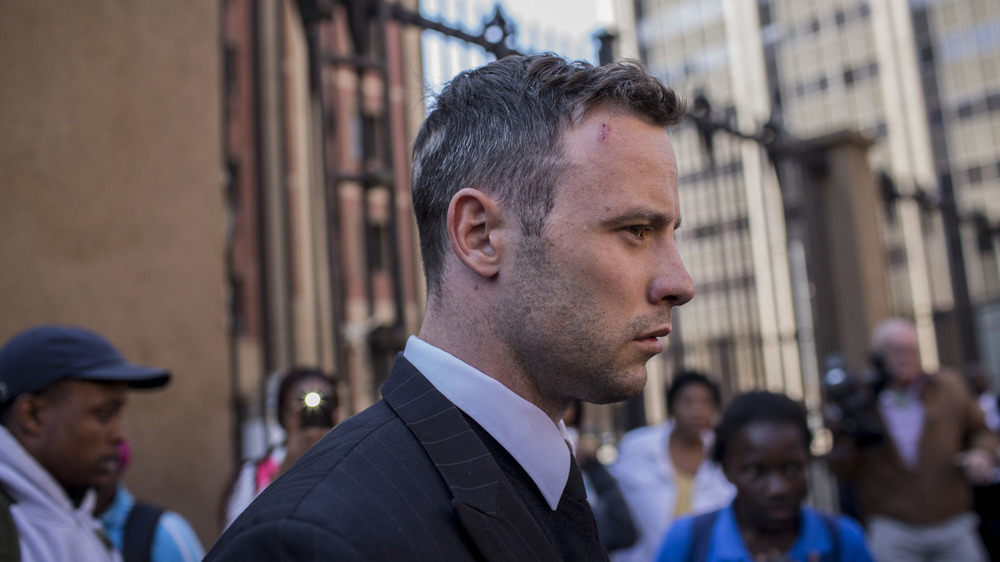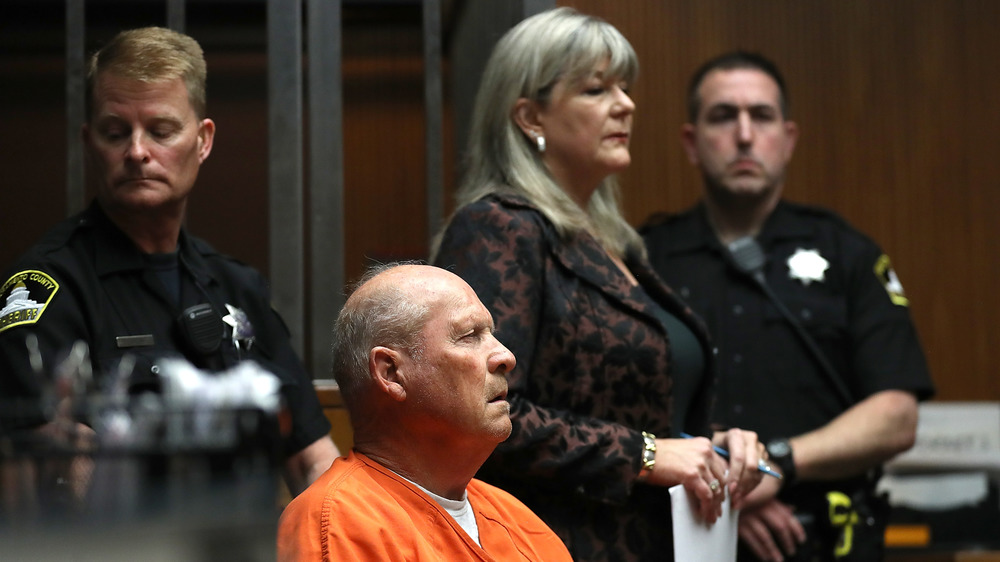The Most Shocking True Crime Revelations, Every Year Since 1999
Correction 10/23/23: A previous version of this article stated that the body of Hae Min Lee was found in a parking lot in Baltimore. Her body was found buried in Leakin Park, not a parking lot.
To say that 21st century audiences are interested in true crime would be an understatement: We are positively obsessed. In 2019, a survey conducted by Civic Science revealed that more than half of Americans had at least some interest in the grisly genre, which, when taken in light of the increasingly fractured entertainment landscape, in which creators more and more cater to the pleasures of devoted niche followings, becomes particularly impressive.
As its audience has grown, true crime as a genre has often been criticized by critics, for understandable reasons. Many take issue with the genre's apparent sensationalism, and the lightness with which gruesome subject matter is handled, while others suggest that the popularity of true crime is evidence of the desensitization of audiences, that in the face of constant on-screen entertainment we demand evermore extreme kicks to keep our collective attention.
These are all legitimate points of contention, and the debate around the positives and negatives of the true crime genre seems unlikely to end anytime soon. However, one thing is worth always bearing in mind when talking about true crime: the basic humanity of the victims of these stories. When people are robbed, abused, or killed at the hands of real-world criminals, the narrative is often forced to follow the motives of the perpetrator; the victims become statistics, whose lives, which are shattered if not lost entirely, are forgotten. We must remember that every single person in these stories is real — and their pain also.
1999: The murder of Hae Min Lee
A common trope of the true crime genre is that, even as technology advances, the unreliability of justice in the face of baffling evidence still exists, and occasionally the true version of dark events can become impossible to ascertain for decades at a time.
Hae Min Lee was an 18-year-old high school student and noted athlete, whose body was discovered buried in Leakin Park in Baltimore, Maryland, on February 9, 1999. She appeared to have been strangled. Per the New York Times, the main suspect quickly became her ex-boyfriend, Adnan Syed, who was subsequently tried and found guilty of her murder.
The circumstances surrounding the murder of Hae Min Lee have become one of the most hotly debated subjects among 21st century true crime audiences thanks to the hit podcast "Serial," first released in 2014. The series threw doubt upon the original trial of Syed, which, according to Biography, rested upon the shaky testimony of his friend, Jay Wilde. Biography states: "Thanks to the worldwide popularity of 'Serial,' Syed's case has captured public interest and spawned a plethora of media projects." It also — though perhaps indirectly — preceded the eventual granting of a retrial, though this was quashed before it could come to court. The murder of Hae Min Lee remains a hotly contested case, and Serial can arguably be pinpointed as the catalyst that started the modern true crime boom.
In an unexpected twist, Syed was released from prison and transferred to home detention on September 19, 2022, after a judge vacated his conviction, according to The New York Times. Citing a failure in prosecuters released helpful evidence as well as two other unidentified potential suspects, Syed is awaiting the possibility of another trial or full dismissal.
2000: The murder of Dariusz Janiszewski
It is hard to believe the sequence of events that led to the identification and subsequent arrest of the killer of Dariusz Janiszewski, a businessman from Wroclaw, Poland, whose body was discovered by a group of fisherman in a lake in December 2000, according to the New Yorker. It involves a frankly unthinkable degree of hubris on the part of the murderer himself, who reveled so vainly in the killing that he simply had to share it with the world.
Janiszewski was found with a rope around his neck, and according to the New Yorker his body "bore marks of torture." He was identified by his mother, after being reported missing a week before the fishermen's gruesome discovery. However, police at the time could find very little evidence of who had actually committed the crime. Six months on from the horrifying discovery detectives decided the case was hopeless, and shelved it.
It was only years later that the case was reopened, following a tip-off concerning the publication of "Amok," a 2003 pulp novel by the author Krystian Bala (pictured), which featured details of a murder uncannily similar to that of Janiszewski. Per the Guardian: "Police uncovered evidence that Bala had known the dead man, had telephoned him around the time of his disappearance, and had then sold the dead man's mobile phone on the internet within days of the murder." In 2007, Bala was found guilty of the murder and sentenced to 25 years in prison.
2001: Armin Meiwes, the polite German cannibal
Cannibalism is counted among humanity's greatest taboos, an abject practice that raises a sense of existential dread whenever it comes to light. Little wonder, then, that the story of Armin Meiwes became one of the world's most sensational global news events in the early 2000s. As described in the Independent, Meiwes came to the attention of police in 2002, when they were directed to online posts soliciting willing participants to be voluntarily eaten. At Meiwes' farmhouse not far from the German city of Dresden, officers discovered a videotape showing the killing of Bernd Brandes, a Berlin-based computer developer whose fantasy had reportedly complemented Meiwes'. His remains were later found in the garden of the same house.
Details of the trial left news audiences agog. Meiwes was amicable and open about his crimes — he even admitted in a magazine interview to "cooking parts of Brandes' body with olive oil, garlic, and pepper and eating them with sprouts and a bottle of South African red wine," according to the Guardian — and "had shown little remorse and was enjoying the attention generated by the trial," per the same source.
There was outrage when Meiwes was sentenced to just eight years for manslaughter, but a retrial found Meiwes guilty of murder. More disturbing still, was the revelation that Meiwes belonged to a wider network of cannibals. "We are talking about dentists, teachers, cooks, government officials, and handymen," an investigator told the court, according to the Guardian.
2002: The disappearance of John Darwin
Quite understandably, the most famous true crime stories of the past few decades involve death, and in retelling these stories we allow real world events to play upon our darkest mortal fears. Some stories, however, are just so absurd that they captivate us by challenging our credulity. The story of John Darwin and his wife, Anne Darwin, is an example of the latter. The two were a typical middle-aged couple from Teesside, in the north of England, and John was an enthusiastic canoeist. According to the Guardian, John was reported missing on a canoe trip in March 2002, and, despite a large-scale search by police and the coastguard, his body was never found. His death certificate was issued the following year, and Anne, along with the couple's two sons, went into mourning.
However, five years after what appeared to have been a tragic boating accident, "[John] Darwin walked into a London police station, claiming he had amnesia, and was reunited with his stunned sons," reports the BBC. But the story doesn't end there. As unbelievable as John Darwin's story already was, it unraveled spectacularly when a photo emerged, taken a year earlier, of John and Anne with a real estate agent in Panama.
It turned out that the couple had colluded on a massive life insurance scam worth hundreds of thousands of British pounds and that in the process of their fraud the pair had deceived everyone, including their own sons, into believing John was actually dead. Both received hefty prison sentences, and the universal disdain of the British press.
2003: Brian Wells, the 'pizza bomber'
Until August 28, 2003, Brian Wells, 46, was just a typical Pennsylvanian pizza delivery driver, according to Erie News Now. But on that day, Wells robbed a bank in a suburb of Erie. He wore a white t-shirt, which bulged noticeably at the front of his chest, per FBI photos on the website for "Pizza Bomber," a book about the case. In one hand he carried a canvas bag, in the other, a cane, which police later realized was a homemade shotgun. He was also, in a show of feigned nonchalance that mimicked Hollywood movies, sucking on a lollipop.
Per Wired, Wells told the teller that he had a bomb fitted around his neck (pictured) and demanded $250,000. She gave him all that she had access to — far less than Wells demanded — and he left. He was apprehended shortly after, but while in custody, the strange box attached to Wells began to beep repeatedly. The bomb was real, and after being detonated by someone else — who was later arrested as an organizer of the heist — it killed Wells. Per NBC, Wells claimed someone else forced him at gunpoint to wear the bomb and rob the bank while he was out on a pizza delivery in what was clearly a fake order to a fake address.
Unsurprisingly, the case has been the subject of numerous documentaries, including Netflix's four-part 2018 release, "Evil Genius."
2004: The Mark and John case
The early 2000s were a simpler time, when the internet was in its infancy, the preserve of tech enthusiasts and teens having yet to break through to gain the near universal usership of today. As such, when the "world wide web" was identified as the catalyst that set a shocking crime in motion, the news seemed all the more disturbing to those who read about the incident offline. In 2004, a 14-year-old British boy, known in the media only as John, "groomed a 16-year-old boy, Mark (both pseudonyms to protect the children), with an 'elaborate matrix of deceit' involving six fictional characters in [an] MSN chatroom and correspondence totaling 56,000 lines of text," according to the Independent. The purpose of the deception? To convince Mark that he should commit murder — and kill John himself.
Posing chiefly as a spy, John convinced Mark that the 14-year-old was suffering from a brain tumor, and that the reward for the killing would lead to a James Bond-like life of money and sex. Horrifyingly, Mark went through with the plan, stabbing John twice on June 29, before calling the police and claiming that an unknown assailant had attacked his friend. John, thankfully, survived the attack he had orchestrated.
At a trial the following year, John plead guilty to "incitement to murder and perverting the course of justice," per the Guardian. Tellingly, the Guardian reported the incident in their "technology" section.
2005: The murder of Janet Abaroa
Apart from the lurid details that are typical of true crime incidents, there is another element that also tends to garner a visceral reaction from audiences: That cold-blooded killers can come so close to getting away with their crimes. Such was the case with the killer of 26-year-old Janet Abaroa, the wife of football player Raven Abaroa. According to NBC, Janet's body was reported to North Carolina police by her husband, who discovered her stabbed to death, with no signs of robbery and their 6-month-old son, Kaiden, unharmed. Per WRAL, Janet was pregnant with her second child.
Raven told police that he had been at a football game at the time of the killing, which occurred, he said, while his wife was getting ready for bed. And for five years, Raven's version of events held up — until, in the hands of a new investigator, there was suddenly a breakthrough. As NBC reports, the fact that Janet's contact lenses were not in their case indicated that she had not been going to bed at all, blowing Raven's account wide open, and he was charged with her murder.
Shockingly, Raven Abaroa, assuming he was clear, had soon remarried, according to ABC, and following the wedding had begun to demonstrate the same cycle of abuse that had characterized his life with Janet and which had ultimately lead to him brutally killing her.
2006: The Richardson family murders
Crimes committed by children are especially disturbing as they seem to suggest that evil is an innate human characteristic — which no one in their right mind would like to contemplate. Evading this thought, perhaps we can assuage our sensibilities with the marginally more palatable belief that, actually, humans have the potential to become well and truly messed-up people far earlier than most of us would like to admit.
"In April 2006, 12-year-old Jasmine Richardson murdered her parents and her 8-year-old brother," runs an opening line from a retrospective of the case on MamaMia. Per the same source, Richardson, from Alberta, Canada, was romantically involved with 23-year-old Jeremy Steinke, with whom she planned the killing of her family as a way of being with the much older man, of whom her family disapproved. Per the NZ Herald, her baby brother's throat was slit, and Steinke stabbed her parents.
Many news outlets, such as NY Daily News, have reported the attack as a copycat, that Richardson and Steinke had been influenced by the 1994 movie "Natural Born Killers" (pictured), which they had recently viewed. But can a film alone really elicit such real-world violence in its viewers?
Richardson is now out of prison, while Steinke continues to serve a life sentence.
2007: The disappearance of Madeleine McCann
There has rarely been a search for a missing person on the scale of that which followed the disappearance on May 3, 2007 of British 3-year-old Madeleine McCann, who was taken from her bed in a Portugal holiday resort while her parents joined friends for dinner at a late night tapas bar, per Biography.
The notorious British tabloids ensured that the ensuing hunt for the missing girl and her abductor expanded into a full-blown media circus, with more than 9,000 sightings of little girl since her disappearance, and dozens of suspects hitting the front pages including her own parents, who were considered prime suspects after being accused in a book about the case by former Portuguese police investigator Gonçalo Amaral, per the Guardian.
Madeleine McCann has never been found. However, in 2020 it was announced that Christian Brückner, a prisoner who was known to have been in the area at the time of the girl's disappearance, was a very strong suspect, according to the Guardian.
In May 2022, the Guardian reported an update on the prime suspect, convicted rapist Christian Brückner. German prosecutor Hans Christian Wolters commented, "We are sure that he killed Madeleine McCann. The investigation is still going on and I think we found some new facts, some new evidence – not forensic evidence, but evidence."
2008: The Fritzl Case
A stomach-churning story that sounds like the premise of a horror novel — or possibly a nightmare — emerged in 2008, when it was revealed that Josef Fritzl, a married father from Amstetten in Lower Austria, had kept a sex slave locked in the windowless basement of his family home for 24 years, per NBC. Even more sickeningly, the victim was his own daughter Elisabeth whom, per the Guardian, Fritzl had first entrapped in the basement at age 18, after asking her to help him fit a door in the very basement that would become her prison.
For five years, she was entirely alone with little to no contact with Fritzl, says the same source, locked in the squalid dungeon that Fritzl had been planning and working on for years by using contacts he knew in the construction industry. According to NBC, Fritzl then covered up his daughter's disappearance by telling his wife that their daughter had run off to join a cult.
Over the course of thousands of daily sexual assaults, Fritzl repeatedly impregnated his own daughter, who was forced to give birth in the basement, alone, seven times. Per NBC, six of these children survived, three of which were then brought up to be raised in the house, Fritzl telling his wife that they were foundlings who had been abandoned on their doorstep.
Fritzl was apprehended after taking one of his imprisoned offspring to hospital for emergency medical attention, where doctors alerted the authorities.
2009: The trial of the Dnepropetrovsk Maniacs
Also known as "the Hammer Maniacs," the story of Viktor Sayenko and Igor Suprunyuck shook their native Ukraine when it began to emerge in the late 2000s, but even today it is barely known outside their homeland — as such, reliable press accounts in English are few and far between. Starting in 2007, the two 19-year-olds began a series of brutal and seemingly mindless slaying, attacking their unsuspecting victims with claw hammers, per ViralNova.
The pair's first victim was an elderly woman, their second, a man sleeping on a bench. They struck twice more the following week, and continued their killing spree until their total number of victims reached 21, murdered over the course of just three months. Per the Russian site GlavRed, the killers were apprehended after one of their targets, a teenage boy, escaped from an attack in which his friend was murdered, and, after originally being accused of the killing, gave adequate descriptions of his assailants which brought them to justice.
The two pathologically cruel teens had made a habit of recording and taking photographs of their slayings — some of which were leaked onto the internet — which were used as evidence against them in their 2009 trial, per Schollufsin. They were sentenced to life imprisonment.
2010: Was the murder of Anni Hindocha planned?
Initially, the violent death of newlywed 28-year-old Anni Hindocha seemed to have been a case of being in the wrong place at the wrong time, but as the story developed, it appeared all was not as it seemed. In November 2010, Hindocha was on her honeymoon in Cape Town, South Africa, with her new husband Shrien Dewani, a British businessman whom she had first met through mutual friends in London in 2009, according to the Guardian. The couple were in a taxi on the way to their hotel when the car was hijacked at gunpoint. Per the BBC, Dewani was released unharmed the same night, while Hindocha's dead body was found days later, in the backseat of the abandoned taxi. She had been shot through the neck.
The murder investigation took so many turns that may still question the official story. Per the Guardian, three suspects were quickly arrested, who alleged that Hindocha's husband had been the brains behind carjacking and robbery.
As the men in custody tried to leverage the idea of Dewani's involvement, details of the businessman's secret bisexuality were made public as a possible motive. After a prolonged extradition battle, per the BBC, Dewani's trial was thrown out due to lack of evidence, and he was acquitted. Hindocha's killers have been jailed.
2011: The Dupont de Ligonnès murders
Xavier Dupont de Ligonnès was — or perhaps, is — an inheritor of one of France's storied family names, a nobleman descended from aristocracy, who operated in the realms of elite finance. With his wife, Agnes Dupont de Ligonnès, Xavier raised four children, three boys and a girl who in 2011 were aged between 13 and 21. Then, in April that year, all five of them went missing without a trace, their bank accounts closed.
"The only message from the family was a mysterious letter from the patriarch Xavier," According to O Magazine, a single letter from Xavier stating he had to enter the witness protection program (also revealing he was a U.S. secret agent) was the only message left indicating the family's whereabouts. Also the children's schools received word the family was moving to Austrailia. A week later, the bodies of Agnes and the children were found buried in the family's backyard, along with those of their two Labradors, according to the New York Times. Each had been shot.
A frenzied hunt began to track Xavier — whom many journalists now believe may have massacred his family as a psychotic reaction to their impending bankruptcy, according to MEAWW – who left behind him a paper trail of his movements across France in the wake of the killings. However, Xavier has never been found either alive or dead, and he remains to this day one of France's most wanted men.
2012: The crimes of Jimmy Savile
Most Brits of a certain age remember the days when Jimmy Savile — a children's entertainer who was knighted by the queen and who spent Christmases in the company of former Prime Minister Margaret Thatcher — was a beloved and omnipresent fixture of British television. He was known for his charity work, with his philanthropy interwoven into his most famous shows, such as "Jim'll Fix It," which between 1975 and 1994 encouraged children to write into the program and have their wishes granted. After he died in October 2011, aged 84, his funeral in the English city of Leeds was, according to the BBC, attended by hundreds of famous friends and fans.
However, his innocent image — Savile was known for his outlandish sportswear, glasses, and prop cigar — faded in the coming months, as it became clear that Savile was under investigation for historic child abuse offences. However, as the Guardian notes, these were hidden from the public by the BBC, for whom Savile had worked for decades, as the allegations clashed with the broadcaster's extensive memorial programming. As more allegations came to light throughout 2012, it became clear that Savile was a compulsive serial abuser, who used his fame and the blind eye of those around him to take advantage of vulnerable children and women, some of whom he had encountered on publicized hospital visits.
It is estimated that Savile abused hundreds of people throughout his career, some as young as two, according to the Guardian.
2013: The Ariel Castro kidnappings
Between 2002 and 2004, three young women in Cleveland, Ohio, went missing, per CNN. The first, 21-year-old Michelle Knight, went missing in 2002. The following year, Burger King worker Amanda Barry disappeared at the age of 16. In 2004, another teenager vanished without a trace: 14-year-old Georgina DeJesus.
It is a shameful fact of life that women continue to go missing in civilized societies. As we have already seen, their abandoned bodies are then discovered. But in the case of what came to be known as the Ariel Castro kidnappings, all three of these women seemed to disappear into thin air, with authorities assuming in the cases of the two teenagers that they had been killed.
That all changed in 2013, when, per a BBC report, the women were unexpectedly found, having been held captive in a Cleveland house for a decade, after Amanda Barry, having been left alone by her captors, attempted to escape, and drew the attention of a neighbor, who informed the police. Three men were subsequently arrested. The name of one, Ariel Castro, was the first to be released to the public. Castro received a life sentence, plus 1,000 years, for the abduction of the three women who testified against him. All three women were reunited with their families. A relative of Georgina DeJesus told the BBC: "We were living every day in the hope she would come home — and she did."
2014: The Slender Man Stabbing
Another disturbing case involving child perpetrators and the internet, this 2014 story involving the chilling influence of the long-armed internet phantasm known as "Slender Man" raised alarm bells for parents around the world as a shocking reminder of the dangers of children's unsupervised web access.
According to the Milwaukee Journal Sentinel, in May of that year three young girls were having a birthday sleepover, but unbeknownst to one of them, the event would end in horrible violence. The morning after the girls' sleepover, the three went into the woods, where Morgan Geyser and Anissa Weier, both 12-years-old, would attack their schoolfriend, Payton Leutner, with a knife, stabbing her 19 times before they left her dying. Fortunately, the victim survived after drawing the attention of a passing cyclist.
The most haunting aspect of the case is that it was premeditated. As details emerged as to the attackers' motive, it became clear that the two young girls had committed attempted murder under the apprehension that they did it to make Slender Man happy, according to NBC, whom they had encountered as a character on social media sites, with Geyser's attorney later arguing in court that "Geyser believed she had to kill or she would be killed herself by the fictional internet character." The girls were charged with attempted first-degree intentional homicide.
2015: The eventual sentencing of Oscar Pistorius
Arguably the crime of the decade, the murder on Valentine's Day 2013 of model and law-graduate Reeva Steenkamp, who was shot dead through the bathroom door of the home of her partner, the Olympian and Paralympian Oscar Pistorius, captivated the world's press for years after. Pistorius himself admitted to the shooting, but claimed that the four lethal shots he fired were, he believed, in self-defense: that he thought an intruder had broken into the house, and was hiding in the bathroom, according to the Guardian.
From the start, Pistorius' version of events seemed implausible, but his demeanor in the courtroom — which included bouts of retching when images of the murder scene were shown, according to the BBC – seemed to swing public opinion in his favor, and though the prosecution described his testimony as a "snowball of lies," per the same source, he was found guilty of culpable homicide instead of murder, and given a five year prison sentence, which, according to the Guardian, upset and surprised many, including legal experts and advocates against sexual assault and domestic violence in South Africa.
However, 2015 saw a successful appeal for a retrial, per the BBC. This time, Pistorius was found guilty of murder, and, after further appeals to extend the length of the initial sentence of six years, Pistorius was ordered to serve 13 years and five months behind bars.
2016: The murder of Christina Grimmie
At a time when YouTubers and social media influencers were growing in visibility — and in which 75% of teenagers consider being a YouTuber as their dream job, according to a survey shared by Mediakix – the murder of internet star Christina Grimmie caused shockwaves beyond her dedicated follower base, and launched scores of think pieces about the potentially toxic nature of viral stardom.
The story of Grimmie's rise to fame is like a snapshot of our age. Per Time: "Aged 15 in 2009, Grimmie uploaded one of her first tracks to YouTube — a cover of 'Party in the USA' by Miley Cyrus ... It went viral. In 2011, she released her first EP, then moved to Los Angeles. In 2014, she came third in the U.S. TV talent show 'The Voice,' extending her popularity beyond her millions of subscribers."
But her tragic death shows little has changed since John Lennon was murdered by a fan on the streets of New York in December 1980. On June 10, 2016, Grimmie was attending a meet-and-greet with around 100 fans following a show in Orlando, Florida, per Film Daily. However, one of the attendants, a 27-year-old man from nearby St. Petersburg had come armed with two guns, and, as Grimmie approached, shot her three times before turning the gun on himself.
2017: The Delphi murders
Teenagers Abby Williams and Libby German were found dead a short distance from Monon High Bridge (pictured), which arches over Deer Creek, Indiana, on February 14, 2017, according to WRTV. Both had been brutally murdered. According to News.com.au, the previous day, the two friends had been hiking through the beauty spot, having been dropped off at 1:35 pm, and they were expected to meet German's grandfather at a nearby carpark to be taken home at around 3:15 pm. The alarm was raised, and a search involving thousands of locals was undertaken before their bodies were finally discovered.
The girls uploaded photos of themselves to social media during their ill-fated hike, but more chilling was what investigators later discovered on German's cell phone, and which police later released to the public: two images of a man — today the prime suspect — who had crossed the very same bridge the girls had; a short audio file of presumably the same man, speaking the words "down the hill"; and finally in April of that year, a few seconds of footage, as shared by WRTV.
On October 31, 2022, the Indiana state police held a press conference announcing the arrest of Richard M. Allen, a resident of Delphi, CNN reported. He pleaded not guilty. And there were still many questions left unanswered, as Superintendent Doug Carter explained, "This investigation is far from complete. And we will not jeopardize its integrity by releasing or discussing documents or information before the appropriate time."
2018: The arrest of the Golden State Killer
Between 1976 and 1986, Californians were terrorized by numerous crime sprees which each earned their own nicknames: there was the Night Stalker, the East Area Rapist, and, before that, the Visalia Ransacker. However, it was only decades later that investigators — aided by advances in both technique and technology — put together the pieces that would eventually see one man brought to justice. According to Biography, that man's name is Joseph James DeAngelo, known today as the Golden State Killer.
The story of his eventual arrest as the sole perpetrator of a litany of violent attacks, sexual assaults, and murders demonstrates how far criminal investigation has come in recent years, and, though this uber-long list of wickedness and barbarism may have caused you to despair for the future of the human species, you can at least take heart at the thought that DeAngelo's capture potentially signals new hope for hundreds of cold cases yet to be solved.
Though it was in the early 2000s that investigators began to piece together that DeAngelo's crimes were linked, it took until 2018 for him to be apprehended, as police followed a DNA trail towards the killer using information culled from a genealogy website, according to the BBC. He ended up making a deal to avoid the death penalty and admitted to 13 murders, a number of sexual assaults, robberies, and other various crimes, per the same source.
2019: Harvey Weinstein finally faced justice
Veteran movie mogul Harvey Weinstein — whose production company has been responsible for some of the most loved films in American cinema — was always known as a nasty character, a bully who pressured those around him into giving into his demands. But although his creepiness towards women in the industry was an "open secret," according to the film producer Emily Best, it was not until the late 2010s that the depravity of Weinstein's behavior and the revelation that he was a sociopathic and compulsive sex offender became common knowledge outside Hollywood circles.
The crimes of Harvey Weinstein are today so well known that they are barely worth retelling. More useful, no doubt, is to highlight how landscape-altering the concurrent #MeToo movement has been in the years since the New York Times first ran the stories of 13 women that Weinstein had been sexually abusive, and had systematically paid off those who accused him of harassment for years (more than 90 women have now come forward, according to Flare).
Weinstein was just the highest profile of the many predators who were brought to justice in recent years thanks to victims of assault bravely stepping forward to share their experiences and challenge the systems that usually keep such crimes covered up. In 2019, he was finally brought to trial, and in 2020 he was given a 23-year prison sentence for rape.
2020: Reynhard Sinaga, 'the most prolific offender ever'
Manchester, a city in the north of England, is known for many things: its famous soccer teams, its rich musical legacy, and its vibrant gay scene. Canal Street in Manchester has become a byword for gay clubbing, and is known for its friendliness, openness, and inclusivity. But the scene's reputation suffered a blow in 2020, when the crimes of one of the city's residents came to light.
According to the Guardian, the crimes of Reynhard Sinaga were first detected by police in 2018, when the then 34-year-old was charged with raping 12 men. The police purposefully tried to keep the crimes quiet the source says, as, despite the charge, they were already beginning to get a sense of the horrifying scale on which the rapist had been operating. Their evidence showed that Sinaga — who, it was revealed, predominantly targeted drunk men, according to the Guardian, lacing their drinks with the drug GHB — may have committed hundreds of rapes going as far back as 2005 (the estimated number now stands at 206, per the BBC).
Sinaga filmed many of the assaults, footage which was used as evidence at his trial in 2020, following which the judge described Sinaga as "highly dangerous, cunning, and deceitful individual who will never be safe to be released," per the Manchester Evening News. He will serve a minimum of 40 years in prison.
2021: the Murdaugh family murders
On June 7, 2021, 911 received a distressing call. As People reports, well-known South Carolina lawyer Alex Murdaugh had found his wife, Maggie Murdaugh, and their 22-year-old son, Paul Murdaugh, dead from gunshot wounds at their property in Islandton. The Murdaughs gained nationwide attention as the case got increasingly complicated. Initially, the police discovered that Paul had been arrested for a boat crash that took the life of a 19-year-old woman (Paul was boating under the influence), as per another article from People. Then, Alex's brothers spoke on "Good Morning America" and claimed that someone had been making online threats to Paul. Just days after the murders, Alex's father, Randolph Murdaugh III, died as well.
On September 4, 2021, Alex survived a shot to the head. As he was recovering, he resigned from his law firm and commented, "I am immensely sorry to everyone I've hurt, including my family, friends and colleagues." On September 7, it was revealed that a few days before, Alex's colleagues had confronted him about a hefty sum of missing money. About a week later, Alex turned himself in. Following severe depression and an addiction to opioids, he had hired a man to kill him so that his surviving son received $10 million in life insurance. He was charged with insurance fraud, conspiracy to commit insurance fraud, and filing a false police report. On July 14, 2022, he was also indicted for the murder of his wife and son.
2022: Babis Anagnostopoulos was revealed as wife and dog killer
In May 2021, 20-year-old Caroline Crouch was found dead inside their Athens home, as the Independent reports. Her baby daughter was crying next to her body, and the family dog, Roxy, had been hung to death. It was Crouch's husband, Babis Anagnostopoulos, crying and claiming that he and his family had been subjected to a botched robbery. As per the Guardian, Anagnostopoulos became a familiar face on the news — a grieving husband and photogenic pilot who gained a lot of sympathy after the tragedy. He spoke well and said heartwarming things, like he hoped no family would have to go through what he had to.
But the truth behind Crouch and Roxy's gruesome deaths was much darker than a failed robbery. In fact, Anagnostopoulos had strangled Roxy so as to make his robbery story more convincing, as per the Independent. It was Anagnostopoulos who strangled his wife to death, and Crouch's diary entries revealed that she had been trying to end the abusive relationship and leave with her baby daughter.
In May 2022, Anagnostopoulos made the headlines again, after he was sentenced to life in prison for murdering his wife, with an additional 10 years for killing Roxy. The identity of the killer had finally been revealed. Crouch's father said, "I am further gratified to know that he will serve his time in Korydallos Prison, the toughest prison in Greece which has one of the worst prison systems in Europe."
